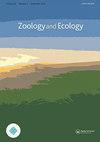Emergence ecology and body size dimorphism in Sympetrum fonscolombii and S. meridionale (Odonata: Libellulidae)
Q4 Environmental Science
引用次数: 5
Abstract
The study of dragonfly emergence provides insights into the understanding of their life history, ecology, and adaptation to abiotic and biotic factors. Here we investigate the emergence ecology and body size of two congeneric dragonflies (Sympetrum fonscolombii Selys, and S. meridionale Selys) in Northeast Algeria, highlighting the seasonal pattern, sex ratio at emergence, sexual size dimorphism (SSD), and vertical stratification. We found that both species, S. fonscolombii in particular, showed quite asynchronous emergence. In both species, and especially in the larger S. meridionale, sex ratio was found to be female-biased, which is in line with the hypothesis of a negative relationship between SSD and sex ratio. There was no seasonal pattern of body size observed in both species. In S. meridionale, SSD with regard to both body and wing sheath length was male-biased, while in S. fonscolombii, it was male-biased with regard to body length and female-biased with regard to wing length. Vertical stratification depended on support height (the higher the support, the higher the height of exuvia fixation) but had a complex relationship with the body size. The biological significance and implications of the vertical stratification-body size relationship are discussed.丰胸交趾虫(Sympetrum foncolombii)和子午交趾虫的出现生态学和体型二态性(Odinata:Libellulidae)
对蜻蜓出现的研究为了解它们的生活史、生态学以及对非生物和生物因素的适应提供了见解。在这里,我们研究了阿尔及利亚东北部两种同类蜻蜓(Sympetrum foncolombii Selys和S.meridionale Selys)的羽化生态和体型,重点介绍了季节模式、羽化时的性别比、性大小二型性(SSD)和垂直分层。我们发现,这两个物种,特别是丰氏菌,都表现出相当异步的出现。在这两个物种中,特别是在较大的南半球,性别比被发现有雌性偏见,这符合SSD和性别比之间负相关的假设。在这两个物种中都没有观察到体型的季节性模式。在S.meridionale中,SSD在体长和翼鞘长方面均偏向雄性,而在S.foncolombii中,SSD则在体长方面偏向雄性,在翼长方面偏向雌性。垂直分层取决于支撑高度(支撑越高,蜕皮固定高度越高),但与体型有复杂关系。讨论了垂直分层体型关系的生物学意义和意义。
本文章由计算机程序翻译,如有差异,请以英文原文为准。
求助全文
约1分钟内获得全文
求助全文
来源期刊

Zoology and Ecology
Agricultural and Biological Sciences-Animal Science and Zoology
CiteScore
1.00
自引率
0.00%
发文量
1
 求助内容:
求助内容: 应助结果提醒方式:
应助结果提醒方式:


